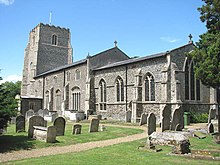Jane Neville, Countess of Westmorland
| Jane Howard | |
|---|---|

St Mary's Church, Kenninghall, burial place of Jane Howard
|
|
| Born | 1533–1537 |
| Buried | 30 June 1593 Kenninghall, Norfolk |
| Noble family | Howard (by birth) Neville (by marriage) |
| Spouse(s) | Charles Neville, 6th Earl of Westmorland |
|
Issue
Margaret Neville
Katherine Neville Anne Neville Eleanor Neville son whose first name is unknown |
|
| Father | Henry Howard, Earl of Surrey |
| Mother | Frances de Vere |
Jane Neville (née Howard), Countess of Westmorland (1533/1537 – buried 30 June 1593), was an English noblewoman.
Jane Howard, born between 1533 and 1537, was the daughter of Henry Howard, Earl of Surrey, and Frances de Vere. Her grandparents on her father's side were Thomas Howard, 3rd Duke of Norfolk, and Elizabeth Stafford. Her maternal grandparents were John de Vere, 15th Earl of Oxford, and Elizabeth Trussell.
Jane Howard had two brothers, Thomas Howard, 4th Duke of Norfolk, and Henry Howard, 1st Earl of Northampton, and two sisters, Katherine Howard, who married Henry Berkeley, 7th Baron Berkeley, and Margaret Howard, who married Henry Scrope, 9th Baron Scrope of Bolton. Jane Howard's youngest sister, Margaret, was born after their father's execution.
Jane Howard's father, the Earl of Surrey, was tried and convicted of treason at the Guildhall on 13 January 1547, and beheaded on Tower Hill on 19 January 1547. In 1548 his children were placed in the care of their aunt, Mary FitzRoy, who appointed the martyrologist, John Foxe, as their tutor.
About 1563/4 Jane Howard married Charles Neville, 6th Earl of Westmorland, who had succeeded to the earldom after his father's death on 10 February 1564. In November 1569 Westmorland joined the Earl of Northumberland in the Northern Rebellion. After initial successes, Westmorland and Northumberland were forced to flee to the Scottish border when Queen Elizabeth sent forces north under the Earl of Sussex. Sussex proclaimed Westmorland and Northumberland rebels at York on 19 November. Shortly thereafter Northumberland was handed over to the Scottish Regent, the Earl of Moray. However Westmorland was given refuge by Lord Kerr at Ferniehirst Castle in Roxburghshire, and eventually escaped by sea in 1570 to the Spanish Netherlands, where he remained an exile until his death. In 1571 he was attainted, and all his honours forfeited. After her husband's attainder, the Queen granted Jane a pension of £200 for life.
...
Wikipedia
